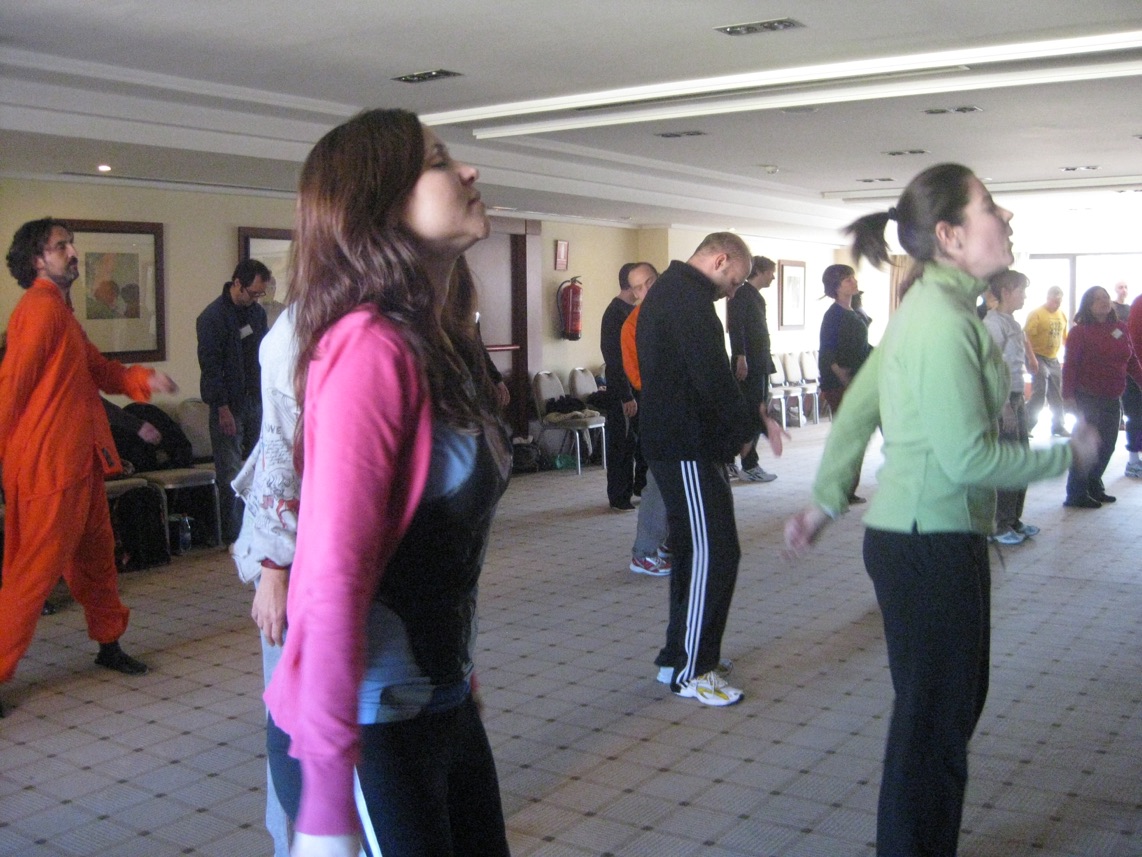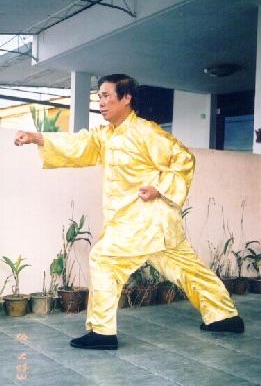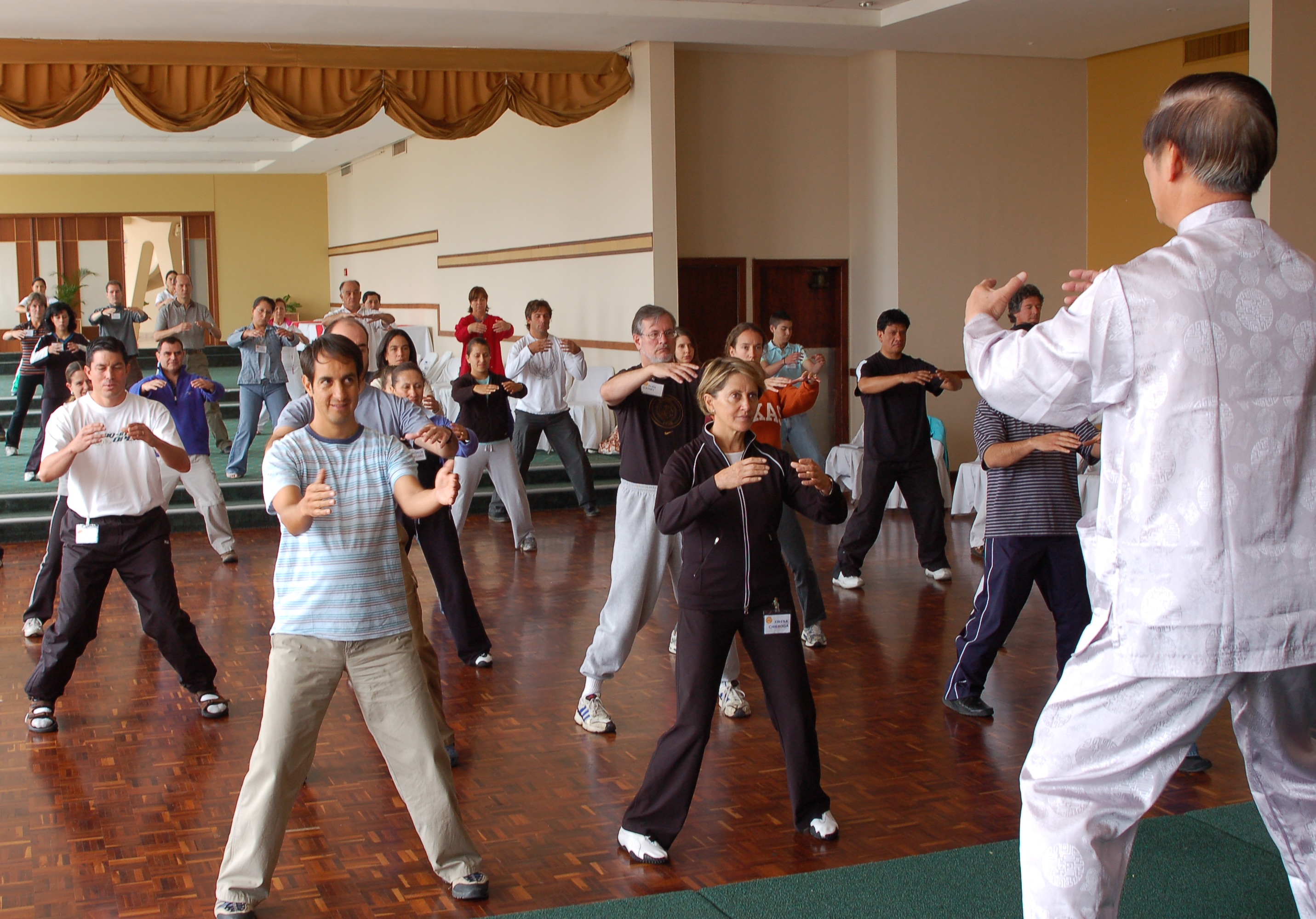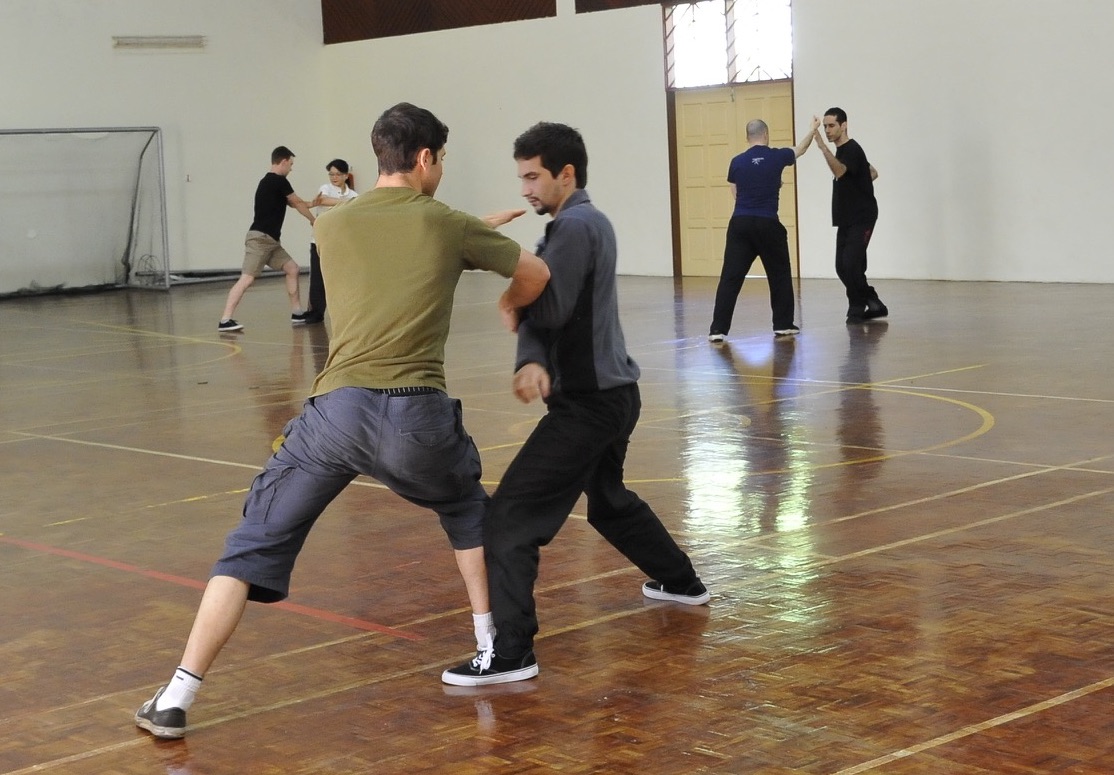SELECTION OF QUESTIONS AND ANSWERS
SEPTEMBER 2016 PART 1

Students at my regional courses could generate a chi flow on the very first day
Question 1
I just started teaching my first Shaolin Chi Kung beginners' class. Before this I had three Taijiquan courses for beginners and advanced level.
To my surprise 80% of all the chi kung students were able to generate a chi flow on the first day.
How can I ensure that I don't teach them too fast, or too high a level, so that their training will be safe?
— Sifu Nessa Kahila
Editorial Note: Please note that this question was asked more than a year ago. Due to a long waiting list, it is only released now.
Answer
It is no surprise that 80% of your students can generate an energy flow on the very first day of your new chi kung class. This is because, I presume, they have taken your Taijiquan classes before. Even if they are new to our school, because you have been well trained as a Shaolin Wahnam instructor, you can lead them to generate an energy flow on the very first day they learn from you.
It is necessary to enter Tao when practicing Wahnam Taijiquan, otherwise students will merely be performing external Taijiquan movements, which is what the great majority of Taiji practitioners do today.
Entering Tao is the same as entering into a chi kung state of mind. As the internal arts of Wahnam Taijiquan are generally more powerful that the 18 Lohan Hands, which form the start of our chi kung syllabus, most of your students can generate a chi flow even when they practice Lohan Hand exercises for the first time.
Nevertheless, the nature of training of Wahnam Taijiquan and of 18 Lohan Hands are quite different. If students use the skills of Wahnam Taijiquan to practice 18 Lohan Hands, it can be over-training. This is because there is a lot of movements in Wahnam Taijiquan, like in set practice and combat sequence practice, whereas the 18 Lohan Hand exercises are performed in a same position.
You need to explain this difference to your students. This point explains why Taijiquan students can practice for an hour whereas chi kung students practice for only 10 to 15 minutes, even when Taijiquan exercises are generally more powerful. Not many people understand this important point.
If the students were new and still about 80% of them could generate a chi flow, it was because you had effectively led them into a chi kung state of mind, and your teaching was excellent. Our certified instructors are very competent, and enable their students to generate a chi flow, indicating that the chi kung they practice is genuine.
It is necessary for the students' benefit to teach at a "low" level. This "low" level is relative. It is very, very high level compared to what students in most other schools practice. It is also very high level compared to what I practiced when I was a student. Even at this "low" level, our students take, at the most, one month to generate an energy flow, whereas most other students would be lucky if they take one year.
Less than 20% of other students can generate an energy flow after one year of diligent daily practice, and their energy flow is nothing like what our students get in one month. The other more than 80% continue to practice chi kung techniques as gentle physical exercise, usually without their knowing the difference.
This "low" level is low compared to the level I teach at an intensive course, or even at a regional course. The chi kung or internal art level of my intensive course or regional course is high because I teach in a few hours what practitioners, if they are lucky, need a few years to attain. Initially the material of my intensive and regional courses was meant for instructors and advanced practitioners, but now I have make the courses available to all students.
A good way to teach and practice at a "low" level, which is very high to other practitioners, is to focus at the form level. It is a good way to get students attain picture-perfect form.
Another excellent way to keep at a "low" level is not to enter too deeply into a chi kung state of mind. In fact, this is, and was in the past, the norm of chi kung practice. Students practice the form over and over again, and eventually, often without their awareness, enter into a chi kung state of mind. We are just ridiculous -- in a good sense; we lead our students to enter into a chi kung state of mind at the very beginning.
Question 2
Is it better to teach at a lower level, so that their progress is slower?
Answer
Yes, it is better to teach at a lower level, but the students' progress is not slower. In fact it will be faster. Whatever it is, it is for the students' best interest. It is teaching students at a level that is best for their purpose.
If we teach at a high level, similar to or even slightly lower than the level I teach in a regional course, students in a regular class may have extraordinary result. Then they over-train and have adverse effects. It will take some time for them to perform remedial exercises to return to good health. This will end up with slower progress.
Why do I teach at a high level in a regional course? This is because I have to accomplish the objective of the course within a few hours. If I teach at the level of a regular class, students will need a few months to accomplish the objective.
As I have often mentioned, a regional course and a regular class serve different purposes, and they are complementary. At a regional course, students learn the techniques, are transmitted the skills, and experience the result first, then they spread out their practice operating with lower skills to make the result lasting. At a regular class, students take time to learn the techniques, develop the skills gradually on their own, and then enjoy the lasting result.

"Black Tiger Steals Heart" is an effective pattern for fa-jing or exploding force
Question 3
Sigung, why was fa-jing, like the palm thrust at the end of the Seven-Star Set, not taught in the Seven-Star Set course. I recall that you taught fa-fing in most kungfu courses.
— Roger, Switerland
Answer
As I had to teach many topics in the three-day Seven-Star course, I had to make a wise selection of topics to be taught within the given time frame.
In this case, topics like generating flowing force, minimizing an opponent's force, striking an opponent directly and swiftly, gripping an opponent's throat or arm with a seven-star hook, and jumping away to award an opponent's attack are more important in the Seven-Star set than fa-jing or exploding force. If I taught fa-jing, there would be less time to teach these more important topics.
Relatively fa-jing is less important in the Seven-Star set than in many other kungfu sets. A Seven-Star exponent does not need much force to cause serious damage poking into an opponent's eye, thrusting into his throat, or kicking his groin.
Question 4
I have a friend who has a family history of Alzheimer's and is very worried about suffering from the disease himself. He has started to do brain training exercises and has asked me if there are any chi kung exercises that would be especially helpful to keep the brain healthy.
My first reaction was that any chi kung exercise performed in a chi kung state of mind would be useful and beneficial but I wanted to ask you if you would recommend any specific exercises before giving him an answer.
— Douglas, Spain
Answer
It is a common belief by people that if they know a particular exercise they can prevent or overcome Alzheimer's or any disease. If this belief were true, there would not be so many people suffering from diseases.
You are right to say that any chi kung exercise performed in a chi kung state of mind would be useful and beneficial. The issue is to perform a chi kung exercise in a chi kung state of mind.
More that 80% of people who practice chi kung today, including those who learn from living instructors, do not perform chi kung exercises in a chi kung state of mind. As a result their practice turn to become gentle physical exercise. Gentle physical exercise cannot prevent or cure any disease, including Alzheimer'.
The best option for your friend is to learn from any of our certified Shaolin Wahnam instructors. Please see http://www.shaolin.org/general/instructors-list.html. Then, he will be able to perform chi kung exercises in a chi kung state of mind.

Stance training is a fundamental skill in all good kungfu
Question 5
Tim, Mark and I have been discussing your email, and our understanding is that for both Shaolin Kungfu and Wudang Taijiquan the fundamental skills are:
- Performing and using stances correctly
- Developing and applying internal force
- Applying techniques and strategies in combat
- Developing and maintaining good health
- Cultivating spirit
— Sifu Barry Smale, UK
Editorial Note: Sifu Barry Smale's questions were asked before the UK Summer Camp 2016. But because there is a long waiting list, the questions and answers are only released now. The UK Summer Camp 2016, which was held in June this year, was a great success. The organizers intend to have the same courses for the UK Summer Camp next year.
Incidentally, the questions here show how much thought and practical care the organizers put into the UK Summer Camp. This, without doubt, was a crucial reason why the UK Summer Camp 2016 was a great success.
Answer
Stance training, internal force, combat application, good health and spiritual cultivation are fundamental skills of all good kungfu in our school. In most other schools, however, their fundamental skills or what students think are fundamental skills, are performing the routines of their kungfu sets.
By fundamental skills I mean that any student learning good kungfu should be trained in these five skills. If he excels in these five skills, the good kungfu becomes great kungfu, and of course the instructor is great too. On the other hand, if none of these skills is found in the kungfu he practices, it is bad kungfu.
Unfortunately, most of the kungfu today, as you can clearly observe, is bad kungfu. Students do not use stances in their fighting, have no internal force, cannot apply what they have learnt in combat, are routinely injured, and are angry and stressful.
In fact I would not even call it kungfu because not only practitioners cannot apply the kungfu they practice for combat, they cannot defend themselves, and they do not even realize it. (There is a difference between applying kungfu for combat, which includes attack, and self-defence.)
They take for granted being hit and kicked in free sparring! How can an art that is devoid of self defence be called an art of self-defence? Kungfu is an art of self-defence.
You mentioned "applying techniques and strategies in combat." To be exact, a fundamental skill of good kungfu is not just applying techniques and strategies in combat, but actually being able to use kungfu for fighting. Many practitioners in other schools, and some students in our school, do apply techniques and strategies in combat, like in arranged sparring, but they cannot use their kungfu in free sparring or actual fighting.
As I have mentioned often, they may still lose to a better fighter, but they can use their kungfu for combat. If an opponent, regardless of whether he is a Boxer, Kick-Boxer, Karateka, Taekwondo exponent, Wrestler, MMA or Muay Thai fighter, gives them a punch, they can respond with a typical kungfu technique, like Single Tiger Emerges from Cave in Shaolin Kungfu, or Immortal Waves Sleeves in Taijiquan.
Question 6
We have taken your categories and worded them like this to make a clear distinction that these are skills rather than techniques or outcomes. Have we understood correctly?
Answer
From your writing ,you have understood me correctly, though I am not sure of the practical effects on your students.
Using two punch pads to let students punch them, like some instructors do, is not training the students in kungfu combat; it is training them to fight like Boxers.
I have mentioned countless times, and I don't want to repeat, yet I shall mention it one more time. Train your students in just one combat sequence many, many times, and let them apply it on other martial artists in free sparring. Not give your students pads and boxing-gloves, and ask them spar like Boxers.
However, you should not intellectualize too much on it. Taking my categories and making a clear distinction that these are skills rather than techniques is unnecessary intellectualization. Just teach your students a suitable combat sequence, and let them practice it over, over and over again, taking care of safety first.
Make arrangement for them to apply the combat sequence on other martial artists. Make sure that they use the combat sequence, and not bounce about like their opponents. Let them enjoy the satisfaction of easily beating their opponents, of course without being vain.

Just practice a combat sequence well and apply it on an opponent in free sparring
Question 7
What we would like to do is to explore each of these areas in greater depth by asking you some more questions - for instance to explore what the subsidiary skills are, their outcomes and the techniques that can be used to train each skill.
If we took the first category - Performing and using stances correctly - what are the key subsidiary or collection of skills in this category? Would you be happy to explain the subsidiary or collection of skills for each category?
Answer
Don't explore each of these areas in greater depth! There is also no need to ask me more questions, like on subsidiary skills, their outcomes and the techniques that can be used to train each skill.
Not only you have understood very well what I already know and do in my teaching and practice, you yourself have attained very high levels. Now put this into practice. We have good kungfu. Just make the good kungfu great -- in practice, not in theory. In other words, your students have excellent kungfu stances, good internal force, are able to use kungfu (not Boxing or Kick-Boxing) in free sparring, are healthy, and are peaceful and happy.
Don't teach the way I teach. It will be detrimental to both yourselves and your students. I teach intensive and regional courses lasting only a few days; you teach regular classes lasting a few months. Both the aims and teaching methodology are different.
Don't intellectualize unnecessarily on the key subsidiary or collection of skills in performing and using stances correctly, as well as on the other fundamental skills. Just teach the kungfu the way we have been teaching it, and our students will have good stances, internal force, be able to use kungfu for fighting, have good health and spiritual joys. Ours is great kungfu. Put it into practice instead of talking about it.
Question 8
We want to be able to explain to people why it would be useful for them to come to the Fundamentals of Kung Fu course, whether they are a beginner or a master, and how it will be different from an Intensive Kung Fu course in Malaysia. Hopefully, in this process we will come to realise more of the depth of your teachings so that we can pass it on in our course explanations.
Answer
I too am very excited about the Fundamentals of Kungfu in the next UK Summer Camp. It is different from the Intensve Shaolin Kungfu Course or the Intensive Taijiquan Course. One important aim is that course participants will be able to use kungfu to defeat other martial artists.
Many of our instructors and students are still not confident in defeating other martial artists. Using our kungfu to confidently defeat other martial artists without hurting ourselves will be an important aim of the Fundamentals of Kungfu course. This aim alone should attract many course participants.
LINKS
Selected Reading
- The Highest of the 72 Shaolin Arts
- Benefits of Practicing Taijiquan
- Lesson from St Pete 2012
- Little Lohan Fist
- North to Chicago
